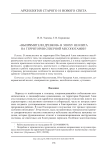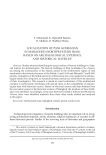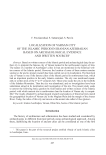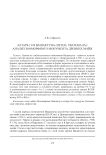Археология старого и нового света. Рубрика в журнале - Краткие сообщения Института археологии

"Выпрямители древков" в эпоху неолита на территории Северной Месопотамии
Статья научная
В эпипалеолите на территории Юго-Западной Азии появляются желобчатые камни особого типа, так называемые «выпрямители древков», которые в докерамическом неолите получают широкое распространение, а к концу керамического неолита практически полностью исчезают. На основе хронологического, картографического, морфологического, контекстного и образно-композиционного анализа данных в работе определены время и места появления, ареал и динамика распространения, региональные особенности нахождения и оформления «выпрямителей древков» Северной Месопотамии в эпоху неолита.
Бесплатно

Статья научная
Studies aimed at identifying the exact location of historic buildings is of special interest for archaeologists. The historic buildings of Panj Gonbadan (Five Domes) are among the constructions of the Islamic period in the northwestern region of Iran mentioned in the historical sources of the Seljuk (5 and 6 AH) and Ilkhanid (7 and 8 AH) periods. Antiquities of the Seljuk period in northwestern Iran were neglected in archaeological studies for a long time, no research has been carried out, which show the necessity of their investigation. This research is aimed at exact localization of this architectural complex in northwestern Azerbaijan with special stress on the compatibility of archaeological data with historical sources. Based on historical sources and data obtained from the excavation season in the historical context of Maragheh, the locations of these buildings were identified. Accordingly, in the area between Gonbad-e Kabood and Modavvar Towers, there were identified materials from three other tombs studied and analyzed in this paper.
Бесплатно

Статья научная
Based on written sources of the Islamic period and archaeological data, the authors try to pinpoint the famous city of Varsan located in the northwestern region of Iran. The names of a number of Azerbaijan's cities in Iran are mentioned in the historical written sources of the Islamic period. However, the location of some of these centers remains unclear so far and no proper research has been carried out on its localization. The historical city of Varsan is one of the famous cities of the Islamic period in northwestern Iran, which had an important position in the early Islamic centuries. The city was mentioned repeatedly in written texts of the 3rd to 5th centuries AH. These texts locate the city in the foothills of the Sabalan Mountains. Then the city was abandoned, and no investigations have been undertaken aimed at its localization and investigation of the site. The present study seeks to answer the following basic question by field studies and written sources of the Islamic period: with which ancient site in northwestern Iran the location of Varsan city is compatible? The results obtained by archaeological research and analysis of historical texts match the geographical location of Varsan city in the Mughan Plain and the margin of the Araxes River. Today, the relics of this city are known as the ancient site called «Ultan Qalasi».
Бесплатно

Алтарь 1 из Вашактуна (Петен, Гватемала): анализ зооморфного монумента древних майя
Статья научная
Одним из слабоизученных памятников Вашактуна - важного политического центра древних майя является алтарь 1, обнаруженный в 1921 г., но до сих пор лишь поверхностно описанный в историографии. Это монумент нерегулярной формы, представляющий собой изваяние в форме черепахи и относящийся к категории т. н. зооморфных алтарей - изображений мифического животного. Панцирь черепахи покрыт плохо сохранившимся рельефом, детальный анализ которого стал возможен благодаря созданию 3Э-модсли алтаря, подготовленной в рамках исследования Регионального археологического проекта Вашактуна (PARU). Данная публикация по священа анализу иконографии и определению роли монумента в истории города. Алтарь 1 связан с мифологическим сюжетом о Боге кукурузы, воскресающем из Космической черепахи, символизирующей земную твердь. В иконографии монумента Бог кукурузы имперсонируется с царем «Носильщик солнца» (его имя записано в головном уборе), правившим на рубеже IV-V вв. и упоминаемым на стелах 4 и 5, а также на настенных росписях здания B-XIII. По аналогии со сходными памятниками мы предполагаем, что алтарь 1 из Вашактуна являлся посмертным монументом «Носильщика Солнца» и был установлен между 402 и 406 гг.
Бесплатно

